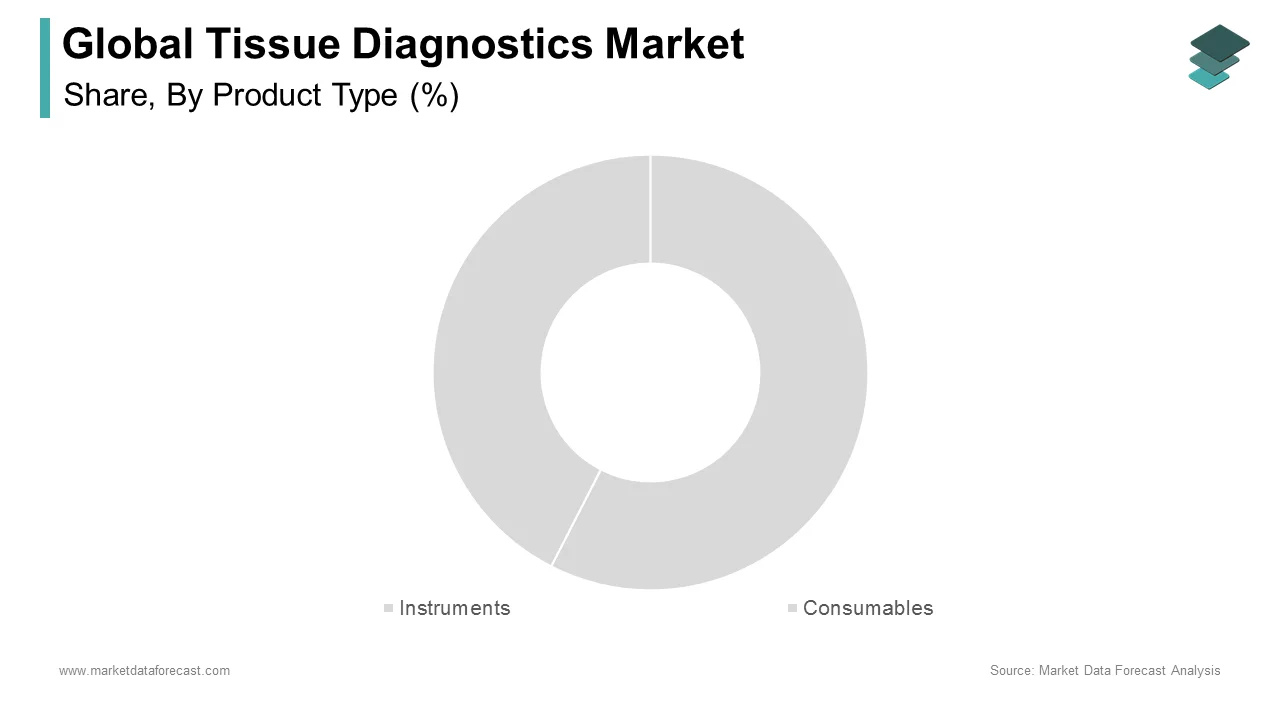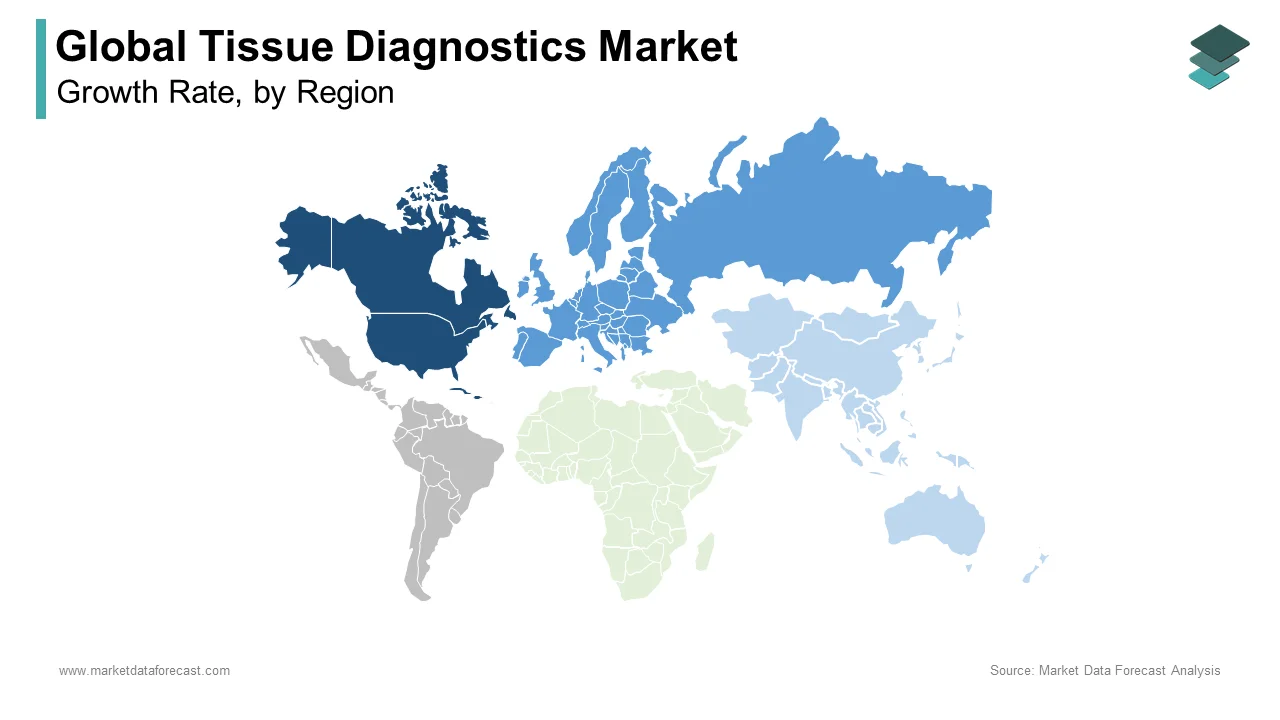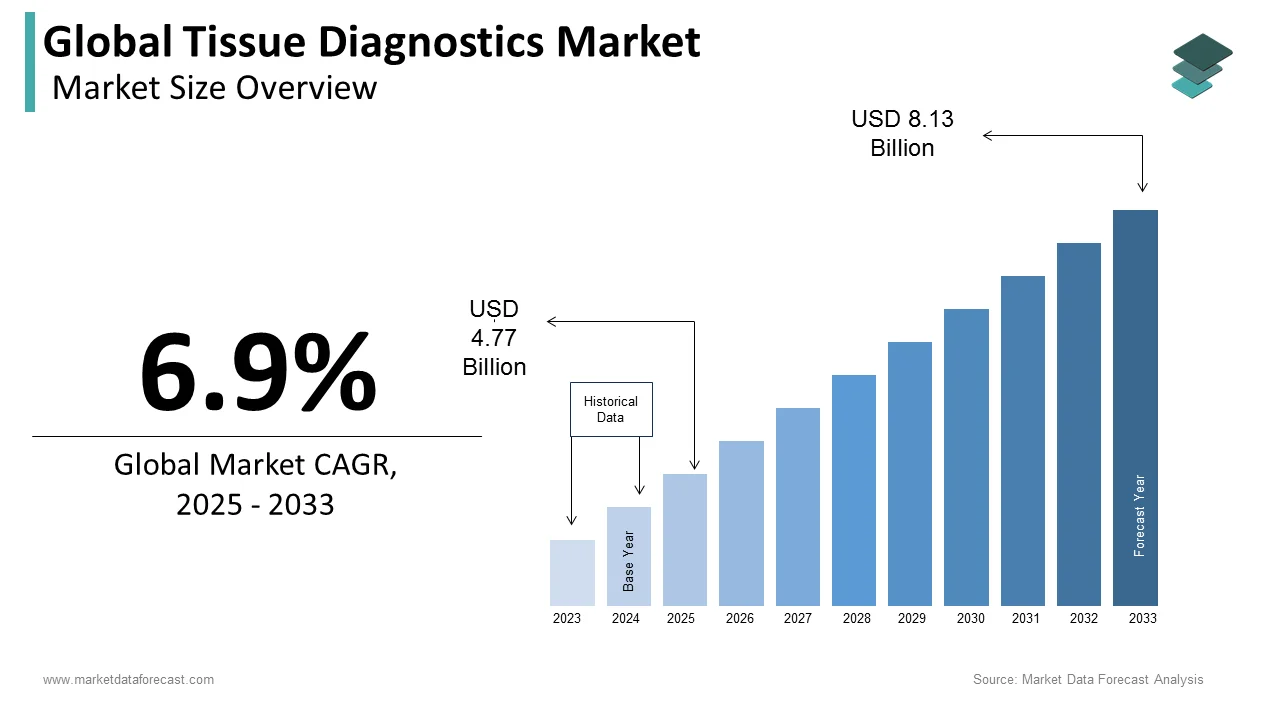Global Tissue Diagnostics Market Size, Share, Trends & Growth Forecast Report By Product Type (Instruments and Consumables), Disease (Lung Cancer, Lymphoma, Pancreatic Cancer, Breast Cancer and Others), Application, End User and Region (North America, Europe, Asia-Pacific, Latin America, Middle East and Africa), Industry Analysis From 2025 To 2033.
Global Tissue Diagnostics Market Size
The size of the global tissue diagnostics market was worth USD 4.46 billion in 2024. The global market is anticipated to grow at a CAGR of 6.90% from 2025 to 2033 and be worth USD 8.13 billion by 2033 from USD 4.77 billion in 2025.
Current Scenario of the Tissue Diagnostics Market
The tissue diagnostics market is experiencing an intense shift that is propelled by technological breakthroughs and an increased focus on personalized healthcare. The integration of artificial intelligence in diagnostic procedures can examine complicated medical data. This will assist in early disease identification and offer more accurate diagnostic outcomes. In addition, the demand for quick and localized testing facilities is fuelling the increase in Point-of-Care Testing. The expansion of portable diagnostic equipment and systems that provide instant testing. It lowers the processing times and allows rapid decision-making in the medical industry. So, this pattern is especially important for handling communicable infections and enhancing patient results.
MARKET DRIVERS
The growing incidence or the prevalence of cancer, wide adoption of cancer diagnosis, and developing healthcare infrastructure for cancer diagnosis are majorly escalating the growth rate of the global tissue diagnostics market.
The growing focus of market participants on enhancing advanced tissue-diagnostic-based companion tests is favoring market growth. In addition, the increasing number of cancer patients and the high adoption of automated tissue diagnostics to diagnose diseases are expected to boost the growth of the tissue diagnostics market. The growing prevalence of cancer, rising healthcare expenses, and increasing funds for research activities to develop cancer treatments are further estimated to contribute to the growth of the global tissue diagnostics market. For instance, in June 2020, the University of Sheffield, United Kingdom, collaborated with Zilico Ltd to design and manufacture real-time medical diagnostics to meet medical needs. Furthermore, increasing lifestyle changes, rising food and tobacco consumption, and alcohol and common lifestyle disorders are predicted to strengthen the tissue diagnostics market. The increasing number of government initiatives to increase awareness regarding efficient early cancer diagnosis propel the tissue diagnostics market growth.
The growing aging population is projected to support the growth of the global tissue diagnostics market.
By 2050, people who are aged 65 years and above will be two times the fold from 2019, as per the World Population Ageing Report 2019. Moreover, 65% of cancer cases and 70% of cancer deaths are seen in older people 65 years and above. The improvement of advanced technologies, high discretionary expenses, and increasing genetic variations bolster the growth rate of the market.
Additionally, factors such as increasing investments in research and development of new technologies, the emergence of efficient and accurate products, growing demand for personalized medicines, and untapped market potential due to the lack of efficient diagnostics tests for non-small lung cancer detection are expected to provide lucrative opportunities for the growth of tissue diagnostics market. Besides, healthcare centers' rising scale is likely to bolster the demand for the tissue diagnostics market.
MARKET RESTRAINTS
The factors that restrain the growth of the global tissue diagnostics market are stringent regulations for the approval of new products and instruments that are highly expensive, lack of accessibility to healthcare indicators in underdeveloped countries, and social stigma associated with cancer. In addition, rural areas are less aware of the new technologies in the medical sector, which quietly hamper the market demand.
REPORT COVERAGE
|
REPORT METRIC |
DETAILS |
|
Market Size Available |
2024 to 2033 |
|
Base Year |
2024 |
|
Forecast Period |
2025 to 2033 |
|
Segments Covered |
By Product Type, Disease, Application, End-User, and Region |
|
Various Analyses Covered |
Global, Regional & Country Level Analysis, Segment-Level Analysis; DROC; PESTLE Analysis; Porter’s Five Forces Analysis; Competitive Landscape; Analyst Overview of Investment Opportunities |
|
Regions Covered |
North America, Europe, APAC, Latin America, Middle East & Africa |
|
Market Leaders Profiled |
F. Hoffmann-La Roche AG, Sigma-Aldrich Co. LLC, Abbott Laboratories, Agilent Technologies, BioGenex, Danaher Corporation, Cell Signaling Technology, Ventana Medical Systems, and Others. |
SEGMENTAL ANALYSIS
Global Tissue Diagnostics Market Analysis By Product Type

The consumables segment had 58.7% of the worldwide market share in 2023. The consumables segment is ruling the tissue diagnostics market and is anticipated to account for a significant share of the global tissue diagnostics market during the forecast period owing to the extensive use of consumables and technological advancements which is leading to the development of novel consumables. Moreover, increased investment in cancer research and life science by government authorities and private establishments, as well as the rise in spending by prominent industry players in R&D activities, are propelling the segment’s market growth. Hence, it is expected to grow rapidly during the forecast period.
Global Tissue Diagnostics Market Analysis By Disease
The breast cancer segment captured 36.4% of the global market share in 2023, and the lead of the breast cancer segment in the global market is projected to continue during the forecast period. In February 2024, a research panel created a computer program to detect and identify possible or probable tumors in the breast. This utilizes observation that notices the tumors spread heat dissimilarly to healthy breast tissue. Other factors causing breast cancer are lifestyle changes, age and consumption of hormone replacement therapy. Moreover, the increased screening activities are further assisting in the expansion of the segment market share.
Global Tissue Diagnostics Market Analysis By Application
The immunohistochemistry segment occupied 47.9% of the global tissue diagnostics market share in 2023 and is expected to witness a noteworthy CAGR during the forecast period. The growth of the immunohistochemistry segment is majorly attributed to the rise in the adoption of products developed based on this technology. In addition, anatomical, immunological and biochemical methods are merged to check particular antigens in tissue by the antibodies in IHC techniques. Further, the discovery and identification of antigens are attained by the application of antibodies which attach to this with great peculiarity.
Global Tissue Diagnostics Market Analysis By End-user
The hospital segment accounted for 45.8% of the global market share in 2023 and is anticipated to expand further during the forecast period. The factors significantly fuelling the growth are the rise in the number of hospitals, improved accessibility and availability of test results in hospitals.
REGIONAL ANALYSIS

North America captured 37.6% of the worldwide market share in 2023 and is predicted to continue holding the domination in the global tissue diagnostics market during the forecast period. Adopting the latest technology and introducing innovative diagnostics procedures in medical sectors magnify the market's growth rate. This is owing to the high incidence rate of cancer across regions. The market recorded the largest revenue share in 2020. It is further likely to register a robust CAGR during the forecast period. The united states accounted for the significant diagnostics market growth and anticipated contributions to the North American regional market growth. Availability of healthcare infrastructure, accessibility to healthcare facilities, and advancement of technology in the healthcare sectors influence the country's market growth. Simultaneously, the Y-O-Y rise in the prevalence of chronic diseases in the U.S. is further adding boss the growth rate of the regional market. In addition, the United States Precision Medicine Initiative is helping to develop the personalized medicine industry. On the other end, the Canadian market is witnessed to showcase healthy growth during the forecast period.
The European Tissue diagnostics market is growing significantly and is more likely to dominate the market with the largest revenue share during the forecast period. The use of human tissue in the production of new experiments is crucial in personalized medicine. Personalized medicine has dramatically grown as sequencing technology and healthcare IT programs have become more widely used in clinical workflows, expected to drive the Tissue Diagnostics market in the region. Germany, the UK, Spain, France, and Italy are the major growth contributors in the region that are expanding the regional market growth. The UK dominates the tissue diagnostics market during the forecast period due to the proliferation of cancer rates. However, government initiatives and favorable reimbursement policies are increasing market growth. Therefore, Germany and France are more likely to contribute to the growth of the European market in the coming years.
Asia Pacific market is likely to witness significant growth during the forecast period due to the increasing focus of government and private sectors in developing nations like China, Japan, India, and others. The Asia Pacific is considered one of the fastest-growing regions globally in the tissue diagnostics market. Emerging countries such as China, India, and Japan are significant growing countries in the APAC region. The market growth in the region is attributed to the growing healthcare sector and active key market players. The Indian market is anticipated to witness significant growth in the tissue diagnostics market during the forecast period. The factors, increasing healthcare expenditure, emerging infrastructure for cancer diagnosis, and support by the government are encouraging market growth in India.
KEY PARTICIPANTS IN THE GLOBAL TISSUE DIAGNOSTICS MARKET
Some of the noteworthy companies dominating the global tissue diagnostic market are F. Hoffmann-La Roche AG, Sigma-Aldrich Co. LLC, Abbott Laboratories, Agilent Technologies, BioGenex, Danaher Corporation, Cell Signaling Technology, Ventana Medical Systems, and Others.
RECENT MARKET DEVELOPMENTS
- In May 2024, a new artificial intelligence software tool was built by a group of experts from A*STAR's Genome Institute of Singapore (GIS) and Bioinformatics Institute (BII). This helps with automatically identifying the cell class present in tissue.
DETAILED SEGMENTATION OF THE GLOBAL TISSUE DIAGNOSTICS MARKET INCLUDED IN THIS REPORT
This report on the global tissue diagnostics market has been categorized into product type, application, disease, end-user and region
By Product Type
- Instruments
- Microscope
- Non-contact Handheld IR Thermometer
- Haemocytometer
- NMR Tube
- Others
- Consumables
- Reagent kits
- Others
By Disease
- Lung cancer
- Lymphoma
- Pancreatic cancer
- Breast cancer
- Others
By Application
- Hematoxylin & Eosin
- Immunohistochemistry
- In Situ Hybridization
By End-user
- Hospitals
- Diagnostic laboratories
- Research Organizations
- Contract Research Organizations
- Biotechnology Companies
By Region
- North America
- Europe
- Asia Pacific
- Latin America
- The Middle East and Africa
Frequently Asked Questions
How is the tissue diagnostics market growing?
The growing incidence of cancer, rising demand for personalized medicine, and the development of new diagnostic technologies are majorly driving the growth of the tissue diagnostics market.
How much is the tissue diagnostics market worth?
The global tissue diagnostics market is predicted to be valued at USD 8.13 billion by 2033.
What are some of the challenges facing the tissue diagnostics market?
High costs associated with diagnostic tests, regulatory hurdles, and the need for skilled healthcare professionals to conduct tests are some of the major challenges to the growth of the tissue diagnostics market.
Who are the major players in the tissue diagnostics market?
Roche, Danaher Corporation, Agilent Technologies, and Thermo Fisher Scientific are some of the major companies in the tissue diagnostics market.
Related Reports
Access the study in MULTIPLE FORMATS
Purchase options starting from
$ 2500
Didn’t find what you’re looking for?
TALK TO OUR ANALYST TEAM
Need something within your budget?
NO WORRIES! WE GOT YOU COVERED!
Call us on: +1 888 702 9696 (U.S Toll Free)
Write to us: sales@marketdataforecast.com

